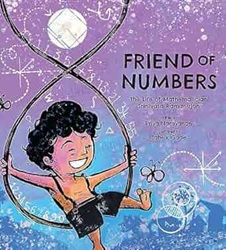Review of The Five Sides of Marjorie Rice, by Amy Alznauer, illustrated by Anna Bron
 The Five Sides of Marjorie Rice
The Five Sides of Marjorie Rice
How to Discover a Shape
by Amy Alznauer
illustrated by Anna Bron
Candlewick Press, 2025. 48 pages.
Review written October 3, 2025, from a book sent to me by the publisher.
Starred Review
Like another book I recently reviewed, Firefly Song, The Five Sides of Marjorie Rice is a picture book biography of a citizen scientist, a woman who made a notable discovery, even though she didn’t have formal training in that field. Marjorie Rice now has a special place in my heart, because in her case, the field was math.
The biography tells us how Marjorie Rice read an article in Scientific American by Martin Gardner and then got captivated with the idea of finding more five-sided convex shapes that tile a plane. And the stellar art by Anna Bron helps make it clear to the reader what this means.
We learn how she was inspired when a new tiling was discovered – to then search for new five-sided shapes of her own that would work. And she went on to find four of fifteen pentagon types that tile the plane. (Years later, other mathematicians found two more, and then another proved that there were no more.)
This amateur mathematician’s life is especially suited for a picture book biography because her work was so visual – and the artist did a great job of using pentagon tilings throughout the book. Back matter not only tells about the pentagon discoveries after Marjorie, they also give the reader great ideas for exploring shapes, tilings, and tessellations further.
I love that this is the story of a housewife with a curious and playful mind (if perhaps a somewhat obsessive one).
Oh look! I’m ready to post this review and looked up the author’s website. She has an MFA in Creative Writing and also teaches calculus and number theory. This makes me feel like she’s a kindred spirit with me, since I have Master’s degrees in Mathematics and in Library Science – not a typical combination. This explains her excellent picture book biographies of mathematicians. I’m going to keep watching for her books.
Find this review on Sonderbooks at: www.sonderbooks.com/Childrens_Nonfiction/five_sides_of_marjorie_rice.html
Disclosure: I am an Amazon Affiliate, and will earn a small percentage if you order a book on Amazon after clicking through from my site.
Disclaimer: I am a professional librarian, but the views expressed are solely my own, and in no way represent the official views of my employer or of any committee or group of which I am part.
Subscribe for more reviews and talk about books.
Join the conversation: What did you think of this book?








